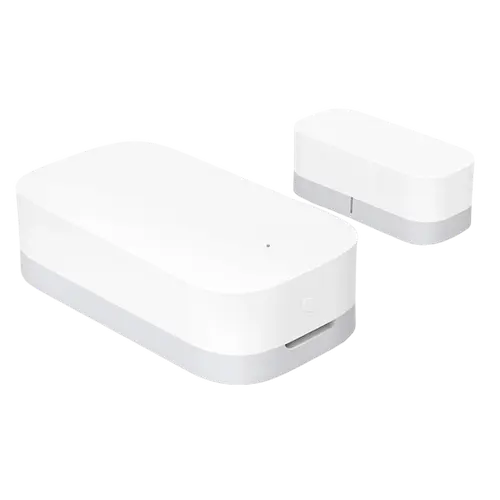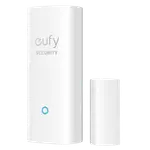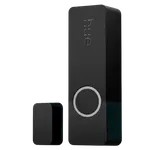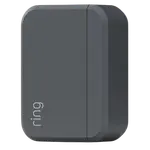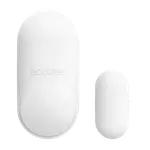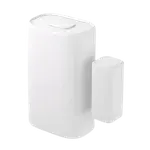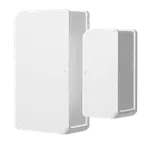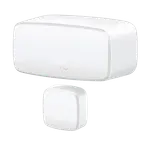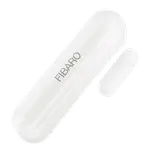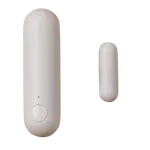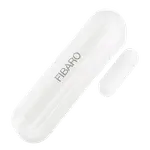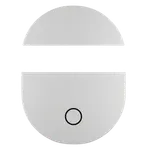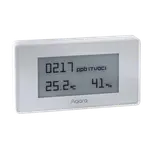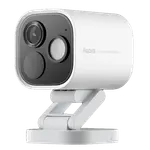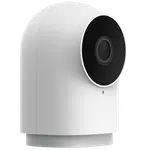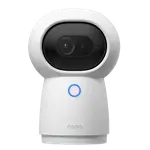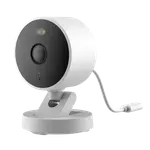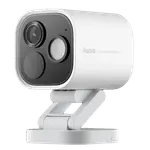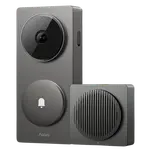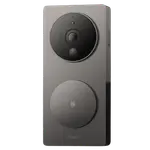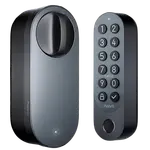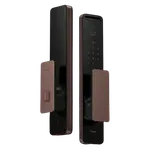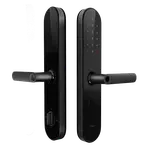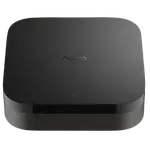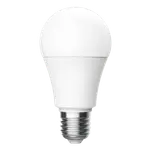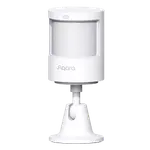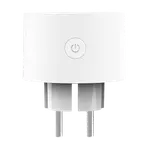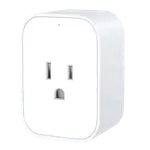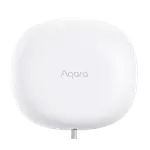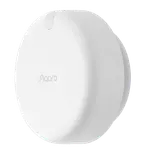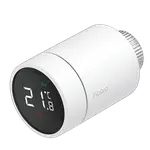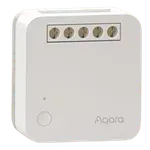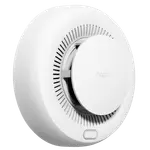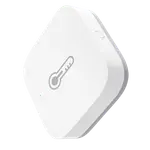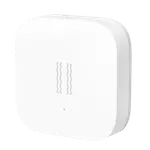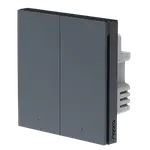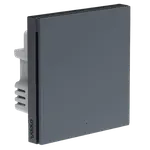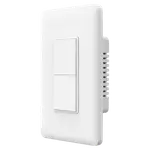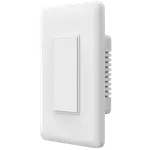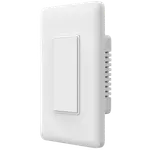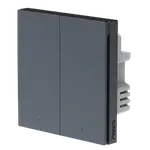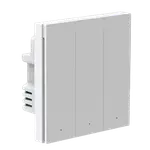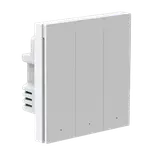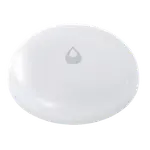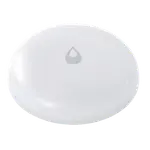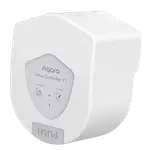Aqara
Door and Window Sensor
Summary
Size & Materials: Sensor Dimensions (41 x 22 x 11 mm)
Connectivity: Zigbee (Zigbee Hub required)
Integrations: Alexa, Apple HomeKit, Home Assistant, IFTTT
Sensors: Door & Window Open/Close
Alerts: Door & Window Open/Close Alerts, Tamper Alerts (Aqara Hub required)
Features: Sensitivity Configuration (Aqara Hub required)
Price History
Loading price history...
| Brand | Aqara |
|---|---|
| Headquarters | |
| Website | https://www.aqara.com |
| @AqaraSmarthouse |
Size & Materials
Devices are typically rated using the Ingress Protection (IP) scale, which indicates the level of protection against dust, solid particles, and moisture.
An IP rating (Ingress Protection rating) is a standardized way to describe how well a device is protected against solids (like dust) and liquids (like water). The rating consists of two digits:
- The first digit represents protection against solid particles (e.g., dust).
- The second digit represents protection against liquids (e.g., water).
First Digit (Protection Against Solids):
- IP0X: No protection against solid objects.
- IP1X: Protection against solid objects larger than 50 mm (e.g., accidental touch by hand).
- IP2X: Protection against objects larger than 12.5 mm (e.g., fingers).
- IP3X: Protection against objects larger than 2.5 mm (e.g., tools or thick wires).
- IP4X: Protection against objects larger than 1 mm (e.g., thin wires or small tools).
- IP5X: Dust-protected. Limited ingress of dust is allowed, but it won't interfere with operation.
- IP6X: Dust-tight. Complete protection against dust, ensuring no ingress of particles.
Second Digit (Protection Against Liquids)
- IPX0: No protection against water.
- IPX1: Protection against vertically falling water droplets (e.g., light rain).
- IPX2: Protection against vertically dripping water when tilted up to 15°.
- IPX3: Protection against water sprayed at an angle of up to 60° (e.g., light splashing).
- IPX4: Protection against water splashes from any direction.
- IPX5: Protection against water jets from any direction (e.g., a garden hose).
- IPX6: Protection against powerful water jets (e.g., heavy rain or washing with a hose).
- IPX7: Protection against temporary immersion in water up to 1 meter deep for up to 30 minutes.
- IPX8: Protection against continuous immersion in water beyond 1 meter.
NO
Length x Width x Height
- Length: the longest side of the device
- Width: the shorter side of the device
- Height: the vertical dimension of the device
41 x 22 x 11 mm
Length x Width x Height
- Length: the longest side of the device
- Width: the shorter side of the device
- Height: the vertical dimension of the device
?
The physical weight of the sensor, typically measured in grams (g) or ounces (oz).
?
The weight of the magnetic component used for door/window detection.
?
Power
Battery-powered sensors typically use standard batteries like AA, AAA, or button-cell batteries (CR2032, CR123A), which are easy to replace and widely available.
CR1632
Sensors that connect via Wi-Fi tend to consume more power due to the constant need to maintain a connection with the network, meaning more frequent battery replacements.
Zigbee, Z-Wave, and Thread Sensors are designed for low-power devices, allowing sensors to last much longer on battery power, often up to 3-5 years before needing a battery change.
Bluetooth Low Energy (BLE) sensors have moderate power consumption, offering a reasonable battery life depending on usage.
2 years
Connectivity
Range: The 2.4 GHz band offers a longer range, meaning it can cover larger areas and penetrate solid objects like walls more effectively than 5 GHz.
Speed: Generally, 2.4 GHz provides slower speeds compared to 5 GHz due to a lower maximum data rate.
Interference: More prone to interference since many other devices (like cordless phones, microwaves, and Bluetooth devices) operate on the 2.4 GHz frequency, leading to potential congestion and slower network performance.
NO
Range: Offers a shorter range compared to 2.4 GHz and may have difficulty penetrating walls and other obstacles.
Speed: Typically provides faster speeds and higher data rates due to more available bandwidth.
Interference: Less prone to interference as fewer devices operate on this frequency, leading to a more stable connection.
NO
Bluetooth is a wireless communication technology used for exchanging data over short distances.
Bluetooth enables devices to communicate wirelessly within a short range, typically up to 10 meters (about 33 feet) for most consumer devices.
NO
Zigbee is a wireless communication protocol designed for low-power, short-range applications, commonly used in smart home devices, industrial automation, and other areas requiring reliable, low-data rate communication. It features low power consumption, making it ideal for battery-operated devices, and supports short-range communication, typically up to 100 meters. Zigbee employs mesh networking, allowing devices to relay data through each other to extend range and improve reliability. It supports data rates up to 250 kbps, suitable for small data packets, and ensures interoperability among devices from different manufacturers if they conform to Zigbee standards. Security is robust, with AES-128 encryption for data protection.
Z-Wave is known for its low power consumption, making it ideal for battery-powered devices. It supports a mesh networking topology, allowing devices to communicate with each other directly or through intermediary nodes, thus extending the overall network range and enhancing reliability. The protocol supports data rates of up to 100 kbps, suitable for transmitting control commands and sensor data.
NO
Zigbee is a wireless communication protocol designed for low-power, short-range applications, commonly used in smart home devices, industrial automation, and other areas requiring reliable, low-data rate communication. It features low power consumption, making it ideal for battery-operated devices, and supports short-range communication, typically up to 100 meters. Zigbee employs mesh networking, allowing devices to relay data through each other to extend range and improve reliability. It supports data rates up to 250 kbps, suitable for small data packets, and ensures interoperability among devices from different manufacturers if they conform to Zigbee standards. Security is robust, with AES-128 encryption for data protection.
Zigbee devices need a Zigbee-compatible hub to connect and communicate with other devices in your smart home setup.
Zigbee Hub required
Thread is a wireless communication protocol designed specifically for Internet of Things (IoT) devices, providing secure, reliable, and scalable networking. Unlike some other protocols, Thread is IP-based, which means it can seamlessly integrate with existing internet infrastructure. It operates in the 2.4 GHz frequency band and uses mesh networking to enhance reliability and extend range by allowing devices to relay data through each other.
Thread is optimized for low power consumption, making it suitable for battery-operated devices. It supports low-latency communication, which is crucial for real-time applications like home automation and security systems. The protocol ensures high security with AES-128 encryption and end-to-end security at the network layer. Thread also supports over-the-air updates, ensuring devices can stay up to date with the latest features and security patches.
Thread-enabled devices require a Thread Border Router (such as certain smart home hubs or routers) to connect to your home network and other Thread devices.
NO
Additional connectivity options not covered by the standard protocols.
This may include proprietary wireless protocols, infrared, or other specialized communication methods.
NO
Integrations
Google Home serves as a central hub for a variety of smart devices, including lights, thermostats, cameras, and speakers. It leverages Google Assistant for voice control, enabling users to manage their smart home with simple commands.
?
Amazon Alexa is one of the most widely used smart home systems, known for its compatibility with a vast array of devices. Users can control everything from smart lights to appliances using voice commands through Echo devices.
YES
Apple HomeKit is designed for users in the Apple ecosystem, providing a seamless way to control compatible smart devices through iOS devices using the Home app or Siri. It emphasizes security and user privacy.
YES
SmartThings is a flexible platform that connects a wide range of devices from different brands, offering a unified interface for control. It supports various communication protocols, allowing for extensive device compatibility.
NO
Home Assistant is an open-source platform that allows for extensive customization and integration of a wide variety of smart devices. It supports a multitude of protocols and brands, making it ideal for tech-savvy users.
YES
IFTTT (If This Then That) is a web-based service that allows users to create simple automation sequences, known as applets, which enable different devices, services, and applications to work together seamlessly. It connects a wide range of products and services, facilitating interoperability and enhancing functionality.
YES
Matter is a unified, open-source connectivity protocol designed to standardize and simplify communication between smart home devices from different manufacturers. Developed by the Connectivity Standards Alliance (formerly the Zigbee Alliance), Matter aims to improve interoperability, security, and reliability across various smart home ecosystems.
Matter operates over existing networking technologies, including Ethernet, Wi-Fi, and Thread, providing flexibility in device connectivity. Its IP-based nature allows seamless integration with existing internet infrastructure and cloud services. Matter uses a mesh networking topology, particularly when operating over Thread, to enhance range and reliability by allowing devices to relay data through each other.
Security is a cornerstone of Matter, with end-to-end encryption and secure device onboarding processes ensuring robust protection for data and privacy. Matter also supports over-the-air updates, allowing devices to stay current with the latest features and security enhancements.
NO
Sensors
Detects when doors or windows are opened or closed.
Door and window monitoring helps secure your home by alerting you when entry points are accessed.
YES
Some door and window sensors come equipped with light sensors to detect changes in ambient light levels. This can be useful for automating lighting or adjusting smart blinds based on natural light conditions.
NO
Motion sensors are another common feature found in advanced contact sensors. These sensors can detect movement near doors or windows, adding an extra layer of security by monitoring not only whether a door or window has been opened but also if someone is near the area.
NO
Occupancy sensors detect whether a room or area is occupied, based on movement or other triggers. These are especially useful in smart home systems that aim to reduce energy consumption by controlling lights, heating, or cooling based on whether a space is being used.
NO
Temperature sensors, sometimes integrated into door and window sensors, can monitor the ambient temperature near doors or windows. This is particularly useful for maintaining a comfortable and energy-efficient home environment.
NO
Alerts
Notifications when doors or windows are opened or closed.
Open/close alerts help you monitor home security and can notify you of unexpected access to entry points.
YES
Notifications when motion is detected in the monitored area.
Motion alerts provide early warning of activity and can help you respond to potential security issues.
NO
Notifications when temperature readings exceed or fall below preset thresholds.
Temperature alerts can help prevent damage to sensitive items and ensure comfortable living conditions.
NO
Notifications when someone attempts to physically interfere with the sensor.
Tamper alerts warn you if someone tries to disable or remove security sensors.
Aqara Hub required
The Tamper Alarm feature will send immediate alerts to your smartphone if the sensor is tampered with.
Notifications when the device's battery level becomes critically low.
Battery alerts ensure you can replace or recharge batteries before the device stops functioning.
?
Features
Adjustable settings to control how easily the sensor triggers.
Sensitivity configuration helps balance security coverage with false alarm prevention.
Aqara Hub required
The ability to create automated actions based on sensor readings or schedules.
Automations can trigger other smart devices, send notifications, or adjust settings without manual intervention.
YES
The ability to track and store historical data over time.
Historical records help you identify patterns, track trends, and review past events for security or optimization purposes.
?
Compare smart contact sensors by connectivity, battery life, alerts, automations, and smart home integrations.
![Ring Window and Door Contact Sensor (2nd gen)]() Ring
RingWindow and Door Contact Sensor (2nd gen)
![Eufy Entry Sensor]() Eufy
EufyEntry Sensor
![Hue Secure Contact Sensor]() Philips
PhilipsHue Secure Contact Sensor
![Aqara Door and Window Sensor]() Aqara
AqaraDoor and Window Sensor
![Ring Outdoor Contact Sensor]() Ring
RingOutdoor Contact Sensor
![SwitchBot Contact Sensor]() SwitchBot
SwitchBotContact Sensor
![Ecobee SmartSensor for Doors & Windows]() Ecobee
EcobeeSmartSensor for Doors & Windows
![Sonoff SNZB-04P ZigBee Door/Window Sensor]() Sonoff
SonoffSNZB-04P ZigBee Door/Window Sensor
![Sonoff DW2-WIFI]() Sonoff
SonoffDW2-WIFI
![Sonoff SNZB-04 ZigBee Wireless Door/Window Sensor]() Sonoff
SonoffSNZB-04 ZigBee Wireless Door/Window Sensor
![Eve Door & Window]() Eve
EveDoor & Window
![Fibaro Door / Window Sensor 2]() Fibaro
FibaroDoor / Window Sensor 2
![Aqara Door and Window Sensor P2]() Aqara
AqaraDoor and Window Sensor P2
![Fibaro Door / Window Sensor]() Fibaro
FibaroDoor / Window Sensor
![Meross Door and Window Sensor]() Meross
MerossSmart Door and Window Sensor
![Arre Tuo Contact Sensor]() Arre
ArreTuo Contact Sensor
![Aqara TVOC Air Quality Monitor]() Aqara
AqaraTVOC Air Quality Monitor
![Aqara CameraHub G5 Pro PoE]() Aqara
AqaraCamera Hub G5 Pro PoE
![Aqara Camera Hub G2H Pro]() Aqara
AqaraCamera Hub G2H Pro
![Aqara Camera E1]() Aqara
AqaraCamera E1
![Aqara Camera Hub G3]() Aqara
AqaraCamera Hub G3
![Aqara Camera G100]() Aqara
AqaraCamera G100
![Aqara Camera Hub G5 Pro Wifi]() Aqara
AqaraCamera Hub G5 Pro Wifi
![Aqara Doorbell Camera Hub G410]() Aqara
AqaraDoorbell Camera Hub G410
![Aqara Smart Video Doorbell G4]() Aqara
AqaraSmart Video Doorbell G4
![Aqara Smart Lock U100]() Aqara
AqaraSmart Lock U100
![Aqara Smart Lock U200]() Aqara
AqaraSmart Lock U200
![Aqara Smart Lock D200i]() Aqara
AqaraSmart Lock D200i
![Aqara Smart Lock N100 Zigbee Edition]() Aqara
AqaraSmart Lock N100 Zigbee Edition
![Aqara Door and Window Sensor]() Aqara
AqaraDoor and Window Sensor
![Aqara Door and Window Sensor P2]() Aqara
AqaraDoor and Window Sensor P2
![Aqara Hub M3]() Aqara
AqaraHub M3
![Aqara Hub M3]() Aqara
AqaraHub M3
![Aqara LED Bulb T1]() Aqara
AqaraLED Bulb T1
![Aqara Motion Sensor P1]() Aqara
AqaraMotion Sensor P1
![Aqara Motion and Light Sensor P2]() Aqara
AqaraMotion and Light Sensor P2
![Aqara Smart Plug (EU)]() Aqara
AqaraSmart Plug (EU)
![Aqara Smart Plug (US)]() Aqara
AqaraSmart Plug (US)
![Aqara Presence Sensor FP1E]() Aqara
AqaraPresence Sensor FP1E
![Aqara Presence Sensor FP2]() Aqara
AqaraPresence Sensor FP2
![Aqara Radiator Thermostat E1]() Aqara
AqaraRadiator Thermostat E1
![Aqara Dual Relay Module T2]() Aqara
AqaraDual Relay Module T2
![Aqara Single Switch Module T1 (No Neutral)]() Aqara
AqaraSingle Switch Module T1 (No Neutral)
![Aqara Single Switch Module T1 (With Neutral)]() Aqara
AqaraSingle Switch Module T1 (With Neutral)
![Aqara Smart Smoke Detector]() Aqara
AqaraSmart Smoke Detector
![Aqara Temperature and Humidity Sensor]() Aqara
AqaraTemperature and Humidity Sensor
![Aqara Vibration Sensor]() Aqara
AqaraVibration Sensor
![Aqara Wall Outlet H2 EU]() Aqara
AqaraWall Outlet H2 EU
![Aqara Smart Wall Switch H1 EU (No Neutral) - Double]() Aqara
AqaraSmart Wall Switch H1 EU (No Neutral) - Double
![Aqara Smart Wall Switch H1 EU (With Neutral) - Single]() Aqara
AqaraSmart Wall Switch H1 EU (With Neutral) - Single
![Aqara Smart Wall Switch (No Neutral) - Double]() Aqara
AqaraSmart Wall Switch (No Neutral) - Double
![Aqara Smart Wall Switch (No Neutral) - Single]() Aqara
AqaraSmart Wall Switch (No Neutral) - Single
![Aqara Smart Wall Switch (With Neutral) - Double]() Aqara
AqaraSmart Wall Switch (With Neutral) - Double
![Aqara Smart Wall Switch (With Neutral) - Single]() Aqara
AqaraSmart Wall Switch (With Neutral) - Single
![Aqara Smart Wall Switch H1 EU (With Neutral) - Double]() Aqara
AqaraSmart Wall Switch H1 EU (With Neutral) - Double
![Aqara Smart Wall Switch H1 EU (No Neutral) - Single]() Aqara
AqaraSmart Wall Switch H1 EU (No Neutral) - Single
![Aqara Smart Wall Switch H1 EU (No Neutral) - Triple]() Aqara
AqaraSmart Wall Switch H1 EU (No Neutral) - Triple
![Aqara Smart Wall Switch H1 EU (With Neutral) - Triple]() Aqara
AqaraSmart Wall Switch H1 EU (With Neutral) - Triple
![Aqara Water Leak Sensor T1]() Aqara
AqaraWater Leak Sensor T1
![Aqara Water Leak Sensor]() Aqara
AqaraWater Leak Sensor
![Aqara Valve Controller T1]() Aqara
AqaraValve Controller T1
![Aqara Door and Window Sensor P2]() AqaraDoor and Window Sensor P2
AqaraDoor and Window Sensor P2![Sonoff SNZB-04P ZigBee Door/Window Sensor]() SonoffSNZB-04P ZigBee Door/Window Sensor
SonoffSNZB-04P ZigBee Door/Window Sensor![Hue Secure Contact Sensor]() PhilipsHue Secure Contact Sensor
PhilipsHue Secure Contact Sensor![Sonoff SNZB-04 ZigBee Wireless Door/Window Sensor]() SonoffSNZB-04 ZigBee Wireless Door/Window Sensor
SonoffSNZB-04 ZigBee Wireless Door/Window Sensor![SwitchBot Contact Sensor]() SwitchBotContact Sensor
SwitchBotContact Sensor![Sonoff DW2-WIFI]() SonoffDW2-WIFI
SonoffDW2-WIFI![Eve Door & Window]() EveDoor & Window
EveDoor & Window![Fibaro Door / Window Sensor]() FibaroDoor / Window Sensor
FibaroDoor / Window Sensor![Meross Door and Window Sensor]() MerossSmart Door and Window Sensor
MerossSmart Door and Window Sensor![Ring Window and Door Contact Sensor (2nd gen)]() RingWindow and Door Contact Sensor (2nd gen)
RingWindow and Door Contact Sensor (2nd gen)![Ring Outdoor Contact Sensor]() RingOutdoor Contact Sensor
RingOutdoor Contact Sensor![Ecobee SmartSensor for Doors & Windows]() EcobeeSmartSensor for Doors & Windows
EcobeeSmartSensor for Doors & Windows![Fibaro Door / Window Sensor 2]() FibaroDoor / Window Sensor 2
FibaroDoor / Window Sensor 2![Arre Tuo Contact Sensor]() ArreTuo Contact Sensor
ArreTuo Contact Sensor![Eufy Entry Sensor]() EufyEntry Sensor
EufyEntry Sensor

